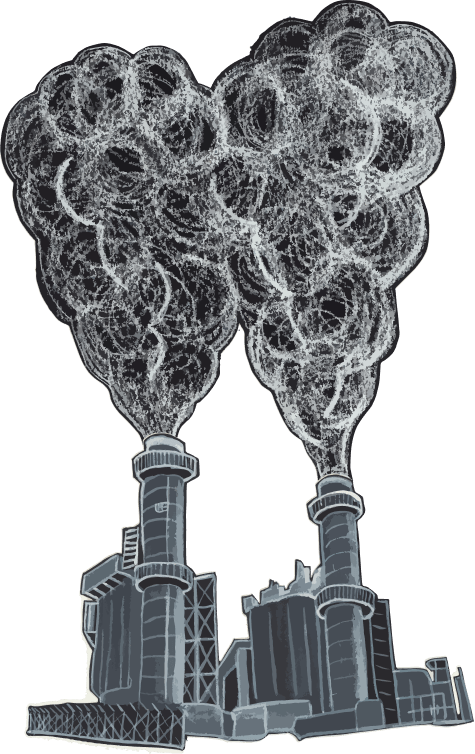Florida
Back to mapTo get to zero by 2050, Florida must cut emissions by 3.8% a year
Emissions in Florida
Million metric tons of carbon dioxide (CO2) equivalent (MTCO2e
) emissions
Note: Grey area indicates missing data due to processing delays.
Source: WRI, Mar 2021
This is how we're going to do it
- Boilers and furnaces with heat pumps
- Gas stoves with electric induction stoves
- No-till farming to keep CO2 in the soil
- Capturing methane leaks from landfills
- Capturing CO2 to make emissions-free concrete
- Burning green hydrogen to make emissions-free steel
- Plugging methane leaks from gas pipelines
Decarbonize Our Buildings
3% of Florida's climate pollution comes from buildings.
We burn fossil fuels to heat our air, water, and food.
To cut this pollution...
Let's electrify our heat!
We'll replace...
...in all of Florida's 7.3 million buildings.
In fact, 84.1% of appliances in buildings in Florida are already fossil fuel free!
That means we only need to electrify the remaining 1.2 million dirty buildings in Florida. That's around 44,000 per year.
Source: Microsoft, Mar 2021; NREL, Dec 2021Electrifying all buildings cuts 3% of the pollution.
Decarbonize Our Transport
42% of Florida's pollution comes from cars, trucks, trains, and planes.
But mostly from cars.
To cut this pollution,
your next car must be electric.
Or consider going car-free with public transit, bikes/e-bikes, car share, or other alternatives!
There are 7.8 million vehicles in Florida and 58,000 are already electric (0.7% of the total).
We need to electrify (or replace) the remaining 7.8 million gas-powered vehicles. That's around 296,000 a year.
Source: DOT, Feb 2021Electrifying all transportation cuts 42% of the pollution.
Decarbonize Our Power
37% of Florida's pollution comes from burning coal, gas, and oil to make power.

That's because of how power is generated in Florida today.
Power Generation in the State of Florida (2020)
But there's already 15% carbon-free electricity generation in Florida!
To clean up the emissions from the polluting power plants we need to replace all fossil fuel power plants with solar and wind farms.

...and find good jobs for those workers.
Current Fossil Fuel Power Plants in Florida
7 coal plants
5,304 MW
3,505 MW
3,308 MW
1,407 MW
1,262 MW
1,229 MW
471 MW
62 gas plants
6,072 MW
4,263 MW
4,174 MW
3,351 MW
3,301 MW
3,268 MW
3,062 MW
2,951 MW
2,798 MW
2,534 MW
2,099 MW
1,970 MW
1,916 MW
1,723 MW
1,452 MW
1,417 MW
1,197 MW
1,114 MW
1,112 MW
1,059 MW
1,017 MW
1,002 MW
994 MW
815 MW
783 MW
728 MW
706 MW
644 MW
611 MW
539 MW
470 MW
411 MW
350 MW
345 MW
343 MW
289 MW
278 MW
275 MW
159 MW
153 MW
146 MW
137 MW
125 MW
122 MW
106 MW
102 MW
70 MW
67 MW
58 MW
54 MW
47 MW
30 MW
25 MW
22 MW
19 MW
14 MW
14 MW
13 MW
12 MW
12 MW
11 MW
9 MW
4 oil plants
227 MW
134 MW
48 MW
25 MW
But wait!
It's not enough to replace our power plants with wind and solar farms.
To power our electric cars and buildings, we need two times the electricity we have today.
In all, we'll need to build 16,000 megawatt (MW) of wind power and 22,000 MW of solar power.
Since the average wind turbine provides 2.75 MW of peak capacity, Florida would need to install about 6,000 turbines.
Since Florida already has 0 MW of wind and 1,000 MW of solar, that's 16,000 MW of wind power we need to build and 20,000 MW of solar power. That's around 628 MW of wind power and 782 MW of solar power a year.
Source: EIA, Apr 2022Decarbonizing all dirty power cuts 37% of the pollution.
And gives us zero-emissions power we need to eliminate pollution from buildings and cars!
Other Emissions
The last 18% of Florida's climate pollution comes from other sources...
This includes farming, landfills, industry, and leaks from gas pipelines.
There's no one solution to solve these problems, but there are lots of great ideas:
That doesn't mean there's no solution, it just means that clean electrification doesn't help with these problems, and you could fill a whole book with covering all of them. We need to encourage our politicians to invest in researching new solutions and implementing existing solutions to these problems!
Ready to do your part?
Learn how to electrify your own machines and pass local policy to electrify the rest
Take Action